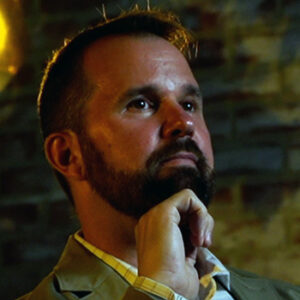
Take a shy kid, throw in some curiosity and kindness, add a splash of imaginary friends and a dash of “Minnesota nice” and bake it like hotdish and you get Jason Paprocki.
Chief Strategy Officer from Arizona Financial Credit Union sits down with the STN Team to talk about growing up in the midwest, the two most important questions he asks, and some of the successful assistance programs he’s helping to lead.
Paprocki also provides his thoughts on reverse mentorship and what he thinks is the best way for an organization to address need in the community.
“I think I can spot the difference between people who really want to do the grunt work and make real change, versus the people who want to show up at an awards dinner or want to get a certificate for their work.”
– Jason Paprocki, AZFCU, Chief Strategy Officer
How the lessons learned when he was little made Jason Paprocki a community-oriented leader
This article has been edited from the original interview for content, length and clarity.
STN:
Where are you originally from and what was it like growing up?
Jason Paprocki:
I grew up in a suburb of the Twin Cities in Minnesota called Apple Valley. A lot of people give me a hard time and say, “It sounds made up, and it does sound made up.” But, it really did exist. I was a very shy kid. I was always in my head. They talk about kids that have imaginary friends. I had imaginary villages. I had imaginary sports teams and I had tons of fun as a kid, but always in my head.
Growing up in Minnesota, I certainly learned people there are incredibly nice. I definitely learned how to treat people with respect, how to be friendly, and open, and be nice to your neighbors.
Being from Minnesota, I also learned a ton about fishing and a lot about hotdish. I’m well-versed in hotdish.
STN:
And what is hotdish?
JP:
Hotdish is what everybody else in the world calls casserole. You throw sauce, noodles, potatoes, meat, and the week’s leftovers into a pan and bake it. That’s pretty much it. Everywhere else calls it a casserole. Minnesota, it’s hotdish.
STN:
What drives your passion for social transformation that you’re currently seeking?
JP:
My approach to leadership, and really just to life, is about curiosity and kindness. If anybody spends any time with me whatsoever, I want them to come away with, “gosh, he was curious, and he was kind.”
To put that into practice, I try to go into every situation asking two questions, what’s going on, and how can I help?
In the beginning, what’s going on and how can I help are questions about your team. You know, what’s the team doing? How can I help my supervisor?
Over a 30-year career, as my scope and influence have grown, what’s going on in my organization and how can I help became what’s going on in the industry and how can I help? For the last several years, it’s been about what’s going on in the community, how can I get involved and how can I help and how can I bring the resources of Arizona Financial to the challenges that are facing our community.
STN:
What do you look for when it comes to collaborating with other leaders and community change-makers?
JP:
I think I can spot the difference between people who really want to do the grunt work and make real change, versus the people who want to show up at an awards dinner or want to get a certificate for their work.
I’m really looking for genuine people with ideas, people with stories to tell me about the impacts that they’ve made. I really like for people to take me or my coworkers out and show us the classroom that you spent time in. If we made a donation, show us what it went toward, and then we’ll be much more motivated to do another.
I’m really looking for the real impact.
STN:
How do you like to be approached for partnership and collaboration opportunities?
JP:
I’m a very informal person. I’m on LinkedIn a lot. I’m very active there. I probably have more fun there than I should. Reaching out via LinkedIn is great.
I like when people reach out and tell me a story. I don’t want your annual report right away. I don’t want your brochure. I write that stuff. I want to hear the story. What you’re actually about, what you’ve done, and what you’re motivated to keep doing in the future. That’s what is really going to get my attention.
STN:
As a leader, how does it make you feel to see some of these things in real-time? Seeing some of the things that you’re able to do and the impact that you’re able to have?
JP:
It’s incredibly rewarding to have the opportunity to see things that I’ve helped create from the ground up from inception, to then be put in place.
A great example is our Local Causes Debit Card program. It’s a debit card we issue designed by a local artist, and every time one of our members uses it money gets set aside in a community fund. It goes back to what’s going on, how can we help?
We thought there were a lot of small nonprofits that were out in the Valley doing great things that just didn’t get the recognition and weren’t on the radar to get funds from a lot of different organizations.
In addition to creating that fund, we have a team that goes out to ask the community, who are these local smaller, hyper-local nonprofits that would benefit from this program?
So we’ve been able to award several thousand dollars at a time. I think over a hundred thousand dollars in the last 18 months or so to smaller nonprofits doing great things.
Another example would be the Million Dollar Teacher Project where we were able to make a donation that went into the classroom and see how it benefited teachers and how it benefited students.
It’s incredibly rewarding to see it go from idea to application.
STN:
From your position as a business leader, what are some of the biggest needs for the community? What are some of those needs out there that if you were to give advice to other business leaders on how to get involved and take action?
JP:
I think it actually starts at an organizational level in getting more of your employees engaged and included. Give all of your employees a place and voice. Create two-way communication so that you can hear from them what’s important and they will help you identify what’s important to them and thus what’s important in the greater community. Creating that visibility and that open communication has led us to find a lot of great causes, a lot of great initiatives, and to make a lot of impact.
For someone in my role, it’s incredibly important to reach out and connect with employees at different levels. Employees of different demographics. Employees of different age groups.
I’ve been reading a lot recently about the concept of a reverse mentor. I’ve had a bunch of reverse mentors over the years and I’ve learned as much from them as they’ve learned from me. I can share my experiences, organizational lessons learned, things that have worked, and probably more importantly, things that didn’t. They share with me, what’s going on in their world and what their topics of interest are.
It’s important for me to create two-way communication and to make sure that they have a voice so that we can learn together.


